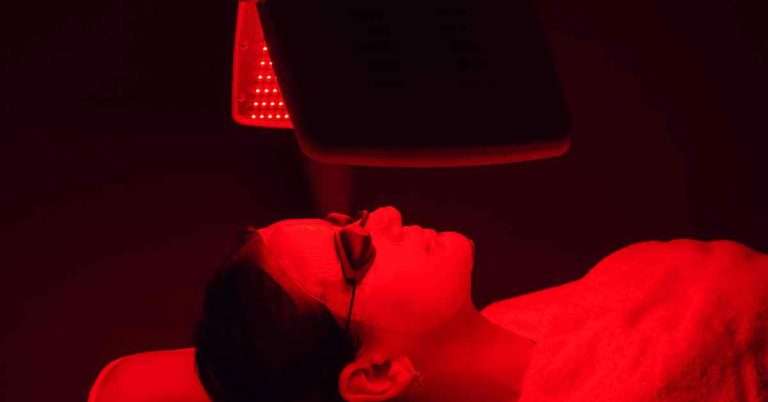Are you exploring non-invasive, scientifically backed, and effective methods for pain relief? Let’s introduce you to infrared light therapy. Backed by numerous scientific studies, this therapy is emerging as a promising alternative to traditional pain medications.
Infra-Red Light Therapy Unveiled

Infra-red light therapy, often called low-level laser therapy (LLLT), harnesses the power of specific light wavelengths to combat pain and inflammation. It also fosters wound healing and deters tissue death. This non-invasive therapy has demonstrated its effectiveness in managing a diverse range of pain types, offering an exciting new alternative to traditional pain relief methods.
- Light Penetration: Infra-red light can penetrate the inner layers of the skin, reaching as deep as 2 to 7 centimeters. This allows it to affect muscles, nerves, and even bones source.
- Cell Stimulation: The therapy acts on the mitochondria, often called the “power plant” of the body’s cells. The light stimulates these mitochondria, enhancing their efficiency and energy production source.
- Healing Promotion: With more energy, cells can perform their functions more efficiently, such as repairing skin, boosting new cell growth, and enhancing skin rejuvenation. Specific cells absorb light wavelengths and are stimulated by it; source.
- Non-Invasive and Painless: The therapy is non-invasive and painless and does not use heat. This makes it a comfortable option for many people seeking pain relief source.
Pain Types Alleviated by Infra-Red Light Therapy
Infra-red light therapy can potentially alleviate various types of pain:
- Dermal Pain: Infra-red light therapy promotes the healing of dermal abrasions, thereby reducing associated pain.
- Acne-related Pain: Studies suggest that infra-red light therapy can treat acne vulgaris, reducing associated pain.
- Skin Condition-related Pain: Research indicates that infrared light therapy might effectively manage pain associated with skin conditions like actinic keratosis.
- Cancer-related Pain: Recent research suggests that infrared light therapy could help manage cancer-related pain.
- Osteoarthritis-related Pain: A study found that red and infrared light therapy reduced osteoarthritis-related pain by more than 50% source.
- Tendinitis: A small study suggests that red light therapy lessens inflammation and pain associated with tendinitis source.
- Muscle Tension: Infrared therapy can help reduce muscle tension, promoting relaxation and improving circulation; source.
- Brain Injury-related Pain: Preliminary studies suggest that near-infrared, low-level light therapy could potentially become a treatment for pain related to moderate brain injuries source.
The Science Behind Infra-Red Light Therapy and Pain Relief

Several scientific studies support the potential of infra-red light therapy as a natural analgesic:
- A study in Lasers in Medical Science found that low-level laser (light) therapy reduces pain and inflammation, promotes wound healing, and prevents tissue death. The study found that wavelengths of 635 and 810 nm were most effective in promoting the healing of dermal abrasions.
- Another study compared the effectiveness and tolerability of topical aminolaevulinic acid-photodynamic therapy in treating acne vulgaris using red light and intense pulsed lights (IPL). The study found that red light and IPL are adequate for this therapy on acne vulgaris.
- Research in Acta Dermato-Venereologica compared the effectiveness of aminolaevulinic acid-photodynamic therapy with red light and green light in treating actinic keratosis, a common skin condition. The study found that red and green light effectively treat this condition, but green light causes less pain.
- More recently, a study in Nanotechnology demonstrated that a bifunctional near-infra-red fluorescent conjugate consisting of chitosan oligosaccharide lactate (COL) and the ZW800-1 NIR fluorophore (COL-ZW) is an effective theranostic agent for fluorescence-guided photothermal treatment.
Top-Rated Infra-Red Light Therapy Products
Based on online reviews, here are some of the top-rated infra-red light therapy products available:
- DGYAO Red & Infrared Light Therapy Device: This device offers red and infrared light therapy for pain relief in various body parts.
- Beurer Infrared Light Heat Lamp: This lamp improves circulation and supports healing. It helps to manage pain in various parts of the body.
- TENDLITE Red Light Therapy Device: This device is FDA-cleared to relieve joint pain. It uses advanced medical-grade technology.
- Hooga Red & Near Infrared Light Therapy Device: This device offers red and near-infrared light therapy. Helps with skin rejuvenation, pain relief, and improved circulation.
Precautions to consider
Although Infrared light therapy is generally considered safe, there are some precautions to consider:
You should consult a healthcare provider if:
- Heat Sensitivity: Some people may be more sensitive to heat than others. If you feel discomfort during the treatment, you must stop the therapy.
- Skin Conditions: If you have any skin conditions, such as recent burns or malignant cancers, you should consult a healthcare provider before starting infra-red light therapy.
- Hyperthyroidism: People with hyperthyroidism, especially in the neck and upper chest area, should be cautious when using infrared light therapy.
- Epilepsy: Infra-red light therapy might not be suitable for people with epilepsy.
- Pregnancy: Pregnant women should avoid using infrared light therapy on their abdomen. However, other areas may be safe.
- Eye Disease: People with eye diseases should avoid direct exposure of their eyes to infrared light.
Conclusion
Infra-red light therapy is emerging as a beacon of hope in pain management. Its ability to penetrate deep into the skin and stimulate cellular activity has shown promising results in alleviating various types of pain. From skin conditions to muscle tension and even brain injury-related pain, this non-invasive therapy broadens the horizons of pain relief options.
However, it’s essential to approach this therapy with an informed perspective, considering individual health conditions and potential sensitivities. Always remember to consult with a healthcare provider before initiating any new treatment.
While this article provides a comprehensive overview of infrared light therapy, it is not intended to replace personalized medical advice. Your journey to pain relief is unique and should be your treatment plan.
More Stories
Find more amazing stories on the blog!
References:




